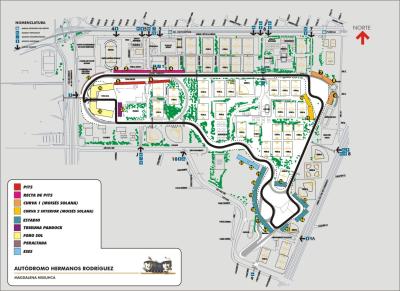Autódromo Hermanos Rodríguez
Circuit Statistics
Location: Mexico 

Established:
Circuit Type:
Race
Turns:
17
Direction:
Clockwise
First Grand Prix Race:
Total Races:
17
About Autódromo Hermanos Rodríguez
The circuit itself has a very bumpy surface, mostly due to Mexico City's location on a geologically active region. Furthermore, with an elevation of 2,285 m,(7,500 ft) the thin air causes difficulties for both the drivers and their cars.
Circuit Information
The circuit itself has a very bumpy surface, mostly due to Mexico City's location on a geologically active region. Furthermore, with an elevation of 2,285 m,(7,500 ft) the thin air causes difficulties for both the drivers and their cars.
The circuit has an extremely fast final corner (the peraltada) before a long start/finish straight, and thus reminded some of Monza; however, unlike Monza's parabolica curve, the peraltada curve is slightly banked, allowing even more speed through the corner. It was at this corner that the younger Rodríguez crashed, although it is unclear whether this was due to excess speed or suspension failure. After the last F1 Mexican Grand Prix in 1992, a baseball stadium was built on the innerpart of this curve. When the Champ Car series began using the track in 2002, the peraltada curve was partially bypassed by a series of sharp turns entering and exiting the baseball field; re-entering the peraltada halfway through.
In the 2005 NASCAR Nationwide Series season, there was a chicane on the main straightaway to slow the cars down. They also introduced a curve between the short course and the Ese del Lago to bypass the latter, but avoiding the stadium detour.
Source: Wikipedia
